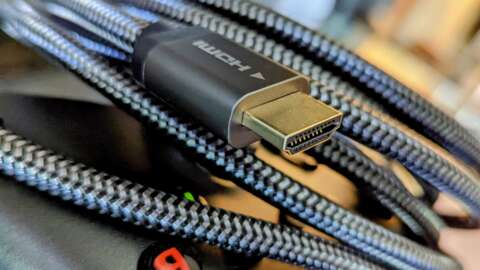The Next HDMI Revision Means Longer Ultra High-Speed Cables
The latest amendment to the HDMI 2.1a spec, which adds HDMI Cable Power, will let us use much longer cables, separating our gear from our screens (via FlatPanelsHD).
The more data you’re pumping through a passive cable, the shorter that cable is going to need to be to preserve the data flowing through it. That’s the case with HDMI 2.1a when compared to its much older cousin, HDMI 2.0. Older HDMI cables could go 30 feet or more while still retaining full bandwidth and connection quality, but HDMI 2.1a represents a huge jump in bandwidth and data needs compared to those older versions, and often maxes out at 10 feet, notes cable maker CableMatters.
That’s where HDMI Cable Power comes in. To make HDMI 2.1a go further than that 10-foot stretch, you need an active–powered–HDMI cable. The HDMI cables behind most of our televisions are passive, and current active cables require a separate power source fed in through a third connector to achieve those longer lengths. HDMI Cable Power will provide power through the HDMI connector itself, instead of adding the extra complexity of a separate connector. HDMI CablePower cables will still, like active HDMI cables, be one-directional, meaning that there’s a defined source and destination end rather than the two being interchangeable like they are with passive HDMI cables.
Right now, there aren’t really any devices that offer HDMI Cable Power, so this is something we’ll see hitting televisions and devices over the next couple of years. When the hardware starts coming out, you’ll need an HDMI cable that supports CablePower, as well as a source device–game console, set-top box, or Blu-ray player–that supports it as well.
For most of us, this is a non-issue. Most home users, even home theater geeks, have their televisions and devices right next to each other. But for someone setting up a truly impressive home theater or looking to run a long cable from their PC in one room to their TV in another, this will eventually be a useful technology. But it will also add additional complexity to the whole process of hooking up new hardware; make sure to check out our article on how HDMI 2.1a is making a previously universal cable standard anything but.
Read MoreGameSpot – Game News




